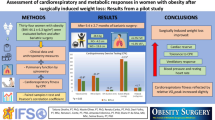Abstract
Purpose
To assess cardiopulmonary capacity, autonomic heart function, and oxygen recovery kinetics during exercise testing before and after bariatric surgery.
Methods
This is a prospective cohort study. Symptom-limited cardiopulmonary exercise testing was performed with 24 patients, 1 week before and 4 months after bariatric surgery. The main variables were maximum oxygen uptake (VO2 max), the time elapsed until the appearance of the first ventilatory threshold (TLV1), and VO2 oxygen kinetics during recovery with a 50% reduction in peak oxygen uptake in the recovery period after exercise (50%VO2RP).
Results
The study demonstrated that the peak VO2\kg increased significantly after bariatric surgery. When analyzed without adjusting for weight, the peak VO2 paradoxically and significantly decreased after the surgical procedure (p = 0.007). The exercise time until the anaerobic threshold was longer after surgical procedure than before it (p = 0.001). Regarding post-exercise oxygen recovery kinetics, there was a faster reduction in the peak oxygen uptake after bariatric surgery than before the procedure (p < 0.001).
Conclusions
There was an obvious cardiac autonomic improvement after surgery. Despite the improvement in exercise tolerance, patients undergoing bariatric surgery had lower maximum oxygen consumption in the analysis not corrected for body weight. The mean VO2RP before bariatric surgery was 141 s and was 111 s after the surgical procedure (p < 0.001). These results suggest an improvement in the recovery kinetics of oxygen consumption, a novel index of cardiac reserve capacity, on patients undergoing bariatric surgery.


Similar content being viewed by others
References
Wang Y, Beydoun MA. The obesity epidemic in the United States-gender, age, socioeconomic, racial/ethnic, and geographic characteristics: a systematic review and meta-regression analysis. Epidemiol Rev. 2007;29:6–28.
Kachur S, Lavie CJ, de Schutter A, et al. Obesity and cardiovascular diseases. Minerva Med. 2017;108(3):212–28.
Xia Y, Fu Y, Wang Y, et al. Prevalence and predictors of atherogenic serum lipoprotein dyslipidemia in women with obstructive sleep apnea. Sci Rep. 2017;30(7):41687.
Beamish CJ, Olbers T, Kelly AS, et al. Cardiovascular effects of bariatric surgery. Nat Rev Cardiol. 2016;13(12):730–43.
Ebong IA, Goff Jr DC, Rodriguez CJ, et al. The relationship between measures of obesity and incident heart failure: the multi-ethnic study of atherosclerosis. Obesity. 2013;21(9):1915–22.
Ebong IA, Goff DC, Rodriguez CJ, et al. Mechanisms of heart failure in obesity. Obes Res Clin Pract. 2014;8(6):e540–e8.
Snoek JA, van Berkel S, van Meeteren N, et al. Effect of aerobic training on heart rate recovery in patients with established heart disease; a systematic review. PLoS One. 2013;8(12):e83907.
Kanoupakis E, Michaloudis D, Fraidakis O, et al. Left ventricular function and cardiopulmonary performance following surgical treatment of morbid obesity. Obes Surg. 2001;11(5):552–8.
Bailey CS, Wooster LT, Buswell M, et al. Post-exercise oxygen uptake recovery delay: a novel index of impaired cardiac reserve capacity in heart failure. JACC Heart Fail. 2018;
Fortin M, ves Turgeon PY, Nadreau E, et al. Prognostic value of oxygen kinetics during recovery from cardiopulmonary exercise testing in patients with chronic heart failure. CJC. 2015;31(10):1259–65.
Serés L, Lopez-Ayerbe J, Coll R, et al. Increased exercise capacity after surgically induced weight loss in morbid obesity. Obesity. 2006;14(2):273–9.
Wilms B, Ernst B, Thurnheer M, et al. Differential changes in exercise performance after massive weight loss induced by bariatric surgery. Obes Surg. 2013;23(3):365–71.
Skinner AC, Perrin EM, Moss LA, et al. Cardiometabolic risks and severity of obesity in children and young adults. N Engl J Med. 2015;373(14):1307–17.
Gastrointestinal surgery for severe obesity. National Institutes of Health Consensus Development Conference Statement. Am J Clin Nutr. 1992;55(2 Suppl):487S–619S.
De Araújo CGS, Herdy AH, Stein R. Maximum oxygen consumption measurement: valuable biological marker in health and in sickness. Arq Bras Cardiol. 2013;100(4):e51–e3.
Hergenroeder AL, Wert DM, Hile ES, et al. Association of body mass index with self-report and performance-based measures of balance and mobility. Phys Ther. 2011;91(8):1223–34.
Wasmund SL, Yanowitz FG, Adams TD, et al. Improved heart rate recovery after marked weight loss induced by gastric bypass: two – year follow up in the Utah Obesity Study. 2012;8(1):84–90.
Gow ML, van Doorn N, Broderick CR, et al. Sustained improvements in fitness and exercise tolerance in obese adolescents after a 12 week exercise intervention. Obes Res Clin Pract. 2015;
Sharma VK, Subramanian SK, Arunachalam V. Evaluation of body composition and its association with cardio respiratory fitness in south Indian adolescents. Indian J Physiol Pharmacol. 2013;57(4):399–405.
Hothi SS, Tan DK, Partridge G, et al. Is low VO2max/kg in obese heart failure patients indicative of cardiac dysfunction? Int J Cardiol. 2015;184:755–62.
Mancini DM, Eisen H, Kussmaul W, et al. Value of peak exercise oxygen consumption for optimal timing of cardiac transplantation in ambulatory patients with heart failure. Circulation. 1991;83(3):778–86.
Steele T, Cuthbertson DJ, Wilding JPH. Impact of bariatric surgery on physical functioning in obese adults. Obes Rev. 2015;16(3):248–58.
Neunhaeuserer D, Gasperetti A, Savalla F, et al. Functional evaluation in obese patients before and after sleeve gastrectomy. Obes Surg. 2017;27:3230–9.
Author information
Authors and Affiliations
Corresponding author
Ethics declarations
All procedures performed in this study involving human participants were in accordance with the ethical standards of the institutional research committee and with the 1964 Helsinki declaration and its later amendments or comparable ethical standards. This research project was approved by the Ethics Committee for Research involving human beings of the Federal University of Pernambuco’s Center of Health Sciences (N. 644.09) CAAE: 00723712.0.0000.5208. The authors declare that they have no conflicts of interests; informed consent was obtained from all individual participants included in the study.
Rights and permissions
About this article
Cite this article
Remígio, M.I., Santa Cruz, F., Ferraz, Á. et al. The Impact of Bariatric Surgery on Cardiopulmonary Function: Analyzing VO2 Recovery Kinetics. OBES SURG 28, 4039–4044 (2018). https://doi.org/10.1007/s11695-018-3469-4
Published:
Issue Date:
DOI: https://doi.org/10.1007/s11695-018-3469-4




